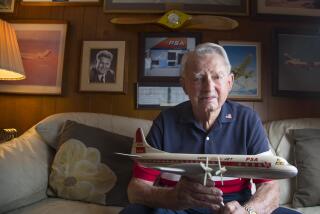THE PAN AM CHRONOLOGY
- Share via
Here are important developments in the history of Pan Am Corp., one of the oldest airlines, America’s unofficial flag carrier and a pioneer in the development of world commercial aviation. Pan Am sought Chapter 11 bankruptcy court refuge Tuesday in response to what it called devastating losses and fuel inflation:
1927--Former naval aviator Juan T. Trippe, 28, founds Pan American Airways, a 28-employee operation that inaugurated history’s first scheduled international flight on Oct. 28--a mail run between a dirt runway in Key West, Fla., and Havana, using a wood-and-fabric Fokker trimotor airplane. Within three months Pan Am was flying passengers between Florida and Cuba. Trippe said his goal was to “provide mass air transportation for the average man at fares he can afford to pay.”
1928--Pan Am opens routes to other Caribbean islands, Mexico, Central and South America; retains transatlantic aviation pioneer Charles Lindbergh as a technical adviser, and becomes the first U.S. airline to use radio communications.
1929--Pan Am becomes the first U.S. airline to serve meals aloft and develop instrument-flying techniques for pilots. It expands operations to link the United States with 23 Latin American nations in a 12,000-mile route system.
1931--Pan Am becomes the first U.S. airline to develop four-engine “flying boats,” giant seaplanes used through much of the 1930s and ‘40s for long-range, over-water trips.
1935--Pan Am launches the first scheduled transpacific service, pioneering regular air travel from the West Coast to Hawaii, Manila and Hong Kong. A San Francisco-Manila flight on the famed China Clipper flying boat takes six days, including overnight stops at island refueling bases.
1939--Pan Am inaugurates first scheduled transatlantic service between New York and Lisbon, Marseilles, France, and Southhampton, England.
1941-45--Pan Am’s operations are channeled into the U.S. war effort, helping ferry warplanes, equipment and soldiers, training military pilots and helping build airfields in 15 countries.
1946--Allies award Pan Am the Internal German Service, the only air link between West Berlin and cities in non-communist West Germany.
1947--Pan Am inaugurates first round-the-world service. It retires the long-range flying boats in favor of faster and more efficient propeller-driven aircraft that can land and take off at conventional airports.
1948--Pan Am inaugurates what later becomes known as “economy class,” a new class of service at prices considerably below the first-class level that had been standard in the industry.
1950--Pan Am changes formal name to Pan American World Airways.
1958--Pan Am becomes the first U.S. airline to fly a commercial jetliner, the Boeing 707.
1962--Pan Am is the first airline to establish a global electronic reservations system.
1966--Pan Am orders the first Boeing 747 jumbo jet.
1968--Trippe retires as chairman and chief executive.
1980--Pan Am merges with National Airlines, the first big airline combination since the industry was deregulated two years earlier. Pan Am establishes flight-training academy that schools pilots for several airlines and the government, including crews of Air Force One, the President’s plane.
1981--Nationwide economic recession and high interest rates begin to take toll on the airline industry. Pan Am negotiates wage cuts and freezes from its five unions and starts selling assets, including its Manhattan world headquarters for $400 million to Metropolitan Life Insurance Co. Still, Pan Am loses $18.9 million for the year.
1982--Chairman and Chief Executive C. Edward Acker begins to trim the work force by 22% and takes other cost-saving steps. But Pan Am still loses more than $480 million for the year and relations between labor and management become strained.
1983-84--Pan Am loses nearly $273 million.
1985--Crippling strike by mechanics ends with new contract calling for 21% pay increase over three years. Pan Am sells key Pacific routes it pioneered to United Airlines for $750 million, which enables it to post a $51.8-million profit for the year.
1986--Pan Am inaugurates Northeast shuttle service between Boston, New York and Washington, one of the busiest air routes in the world but continues to absorb punishing losses because of fierce competition. Loss for the year exceeds $462.8 million.
1987--Passed up as a merger candidate, Pan Am’s condition deteriorates further, hurt by the dollar’s falling value, the Chernobyl nuclear accident and passenger fears of terrorist acts against airlines. Airline loses more than $265 million.
1988--Acker is replaced by Thomas Plaskett, a veteran airline executive. Labor tensions increase, particularly with the Teamsters union. Terrorist bombing of Pan Am Flight 103 over Lockerbie, Scotland, severely hurts Pan Am’s overseas business. Losses for year total $72.7 million.
1989--Flight 103 disaster continues to dog Pan Am. Plaskett says outlook is improving, but loss for year totals $336.6 million.
1990--Pan Am sells German service to Lufthansa and negotiates a $400-million sale of other key routes to United Airlines, leaving the airline with little except its Latin American route system. Persian Gulf crisis spikes jet fuel prices, contributing to Pan Am’s $269-million loss for the first nine months of the year. Trans World Airlines tentatively offers to buy Pan Am for $375 million, but negotiations stall.
1991--Pan Am seeks bankruptcy court protection.
Pan Am At-A-Glance Business: Airline Employees: 26,000 Headquarters: New York Main hubs: New York (JFK), Miami Aircraft: 158 Daily departures: 399 Passengers: 17.2 million (1989) (7th highest) Revenue: 29.4 billion (1989) passenger miles: (9th highest)
More to Read
Inside the business of entertainment
The Wide Shot brings you news, analysis and insights on everything from streaming wars to production — and what it all means for the future.
You may occasionally receive promotional content from the Los Angeles Times.










